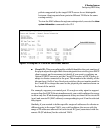
IP Routing Features
Configuring DHCP Relay
Switch
Client
DHCP
Option 82
Server
Relay Agent 1 adds an Option 82 field to a
client request, and then forwards the
request toward the server. This includes
any client requests received from Relay
Agent 2 without an Option 82 field.
Note: DHCP Option 82 does not operate
with clients on VLAN 4 because DHCP
requests from these clients are not routed.
Relay Agent 2 does not add an Option 82
field to client requests before forwarding
the requests. However, any client
requests received from Relay Agent 3 will
be forwarded with the Option 82 fields that
were added by Relay Agent 3.
Relay Agent 3 adds an Option 82 field to a
client request and then forwards the
request.
Client
Client
Switch
Relay Agent “2”
VLAN 1
VLAN 2
VLAN 3
VLAN 2
VLAN 3
VLAN 4
Switch
Client
Switch
Client
Switch
Client
Client
Relay Agent “1”
Relay Agent “3”
No Option 82
Option 82 Enabled
Option 82 Enabled
Client
Figure 3-20. Example of DHCP Option 82 Operation in a Network with a Non-Compliant Relay Agent
Option 82 Field Content
The Remote ID and Circuit ID subfields comprise the Option 82 field a relay
agent appends to client requests. A DHCP server configured to apply a
different IP addressing policy to different areas of a network uses the values
in these subfields to determine which DHCP policy to apply to a given client
request.
■ Remote ID: This configurable subfield identifies a policy area that
comprises either the routing switch as a whole (by using the routing
switch MAC address) or an individual VLAN configured on the routing
switch (by using the IP address of the VLAN receiving the client request).
• Use the IP address option if the server will apply different IP
addressing policies to DHCP client requests from ports in different
VLANs on the same routing switch.
• Use the Management VLAN option if a Management VLAN is config-
ured and you want all DHCP clients on the routing switch to use the
same IP address. (This is useful if you are applying the same IP
addressing policy to DHCP client requests from ports in different
VLANs on the same routing switch.) Configuring this option means
the Management VLAN’s IP address appears in the remote ID subfield
of all DHCP requests originating with clients connected to the routing
switch, regardless of the VLAN on which the requests originate.
• Use the MAC address option if, on a given routing switch, it does not
matter to the DHCP server which VLAN is the source of a client
request (that is, use the MAC address option if the IP addressing
3-52


















